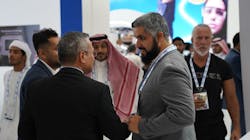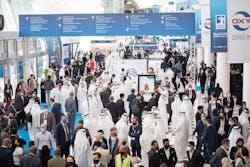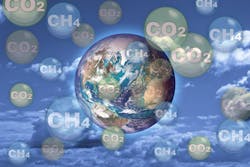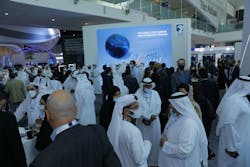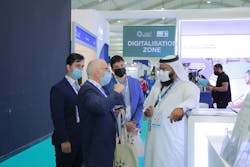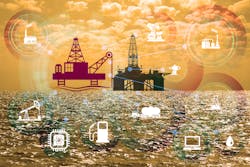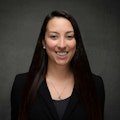By Ariana Hurtado, Editor and Director of Special Reports
Offshore caught up with some of the industry experts visiting ADIPEC 2022 this week. These thought leaders, each of which is with a company speaking at the conference this year, provided their perspectives on where the offshore energy sector stands and the areas that need to be addressed heading into 2023.
MONDAY
Treating methane emissions
—Bjorn Otto Sverdrup, Chair of Executive Committee, Oil and Gas Climate Initiative (OGCI)
“Offshore energy production is essential for the energy and national security of our nation and that of our allies. Global energy demand is increasing and is expected to do so for decades to come. All energy resources are needed to meet growing worldwide demand. Every day, the energy services sector is innovating, developing and implementing new technologies that lead to cleaner, more efficient energy production. To expand offshore production, we need a level regulatory playing field, a full resumption of offshore lease sales, increased investment opportunities in infrastructure and workforce development, and a stop to the negative rhetoric about the industry. I’m optimistic about the future of offshore energy development and know our workforce will be in the forefront of its success.”
—Leslie Beyer, CEO, Energy Workforce and Technology Council
Addressing offshore wind challenges
—Roland Roesch, Acting Director, IRENA’s Innovation and Technology Center
TUESDAY
“As industry aims to strike an equitable and pragmatic balance of efficient, responsible and sustainable energy, the key challenge facing offshore developers today is ensuring maximum production while reducing carbon intensity. Over the medium term, significant investment will be made in offshore developments in the Middle East to meet the increasing demand for supply and, at Wood, we remain focused on engineering solutions to optimize production while reducing carbon impact across the region.”
—Mike Collins, Executive President, Projects, Wood Plc
Lower-carbon offshore solutions
“Many offshore operators face a daily challenge: how can they increase production and minimize their carbon footprint? The solution requires a combination of sensor data, data analytics, electrical controls, and highly reliable subsea and subsurface equipment. Today, Halliburton and TechnipFMC collaborate to provide this combined solution in an all-electro-optic system architecture for wells. This enables a step change in operational efficiency with less production deferment and improved reservoir management. In 2023 this alliance will continue to support all electric well completion architecture as well as riser-less light well intervention and CCUS efforts.”
—Michael Segura, Senior Vice President, Completions and Production division, Halliburton
WEDNESDAY
Maintaining safety and enabling sustainability
“The key issue today is meeting production objectives, while also minimizing emissions. This will take embracing new monitoring and control technology solutions, so that we can find and fix problems faster. Offshore leaders need to understand that it is time to embrace new opportunities that maintain safety and enable sustainability. By taking action in the upcoming year or two, we will be able to achieve net-zero goals for 2030 and beyond.”
—Peter Harding, Founder and CEO, Kelvin
“One of the energy industry’s main targets is to contribute positively towards the energy transition. The industry has recognized that it can drive the transition forward in two ways: by broadening its own investments in energy production, while making its existing energy operations more efficient and lessening their impact on the environment. Digital transformation will be critical for enabling these efficiencies and environmental improvements, as greater access to data will help operators more quickly identify opportunities to improve and deliver on these goals. What’s needed are powerful AI-driven software capabilities to get more value out of data and the power of hybrid cloud to enable insights to be shared cross borders. The need to meet ever-growing energy demands in a safer yet more efficient way whilst also navigating increasing regulatory and environmental requirements will continue to drive the industry to increased digitalization across all component parts of production. The key focus areas will continue a path to autonomous operations, edge devices, security, wearables with a focus on safety and increased use of robotics, which require increased connectivity via private 5G deployment for near-shore and offshore operations.”
—Zahid Habib, Vice President, Global Industry Leader, Energy & Resources IBM Consulting
Adapting to new offshore wind regions
"While the offshore wind market is growing globally, our customers are facing increased levels of competition, which places obvious pressure on price and profitability of their wind portfolios. At Amazon Web Services [AWS], we work with the largest offshore wind developers and show them how they can leverage their data and their experience to optimize the performance of their projects to maximize their opportunities. Our customers are looking to export their offshore wind experience in Europe to the East Coast of the United States, and then beyond in the coming years. It is important to adapt their knowledge to the new regions they are entering and tighten their business models. Simulation and forecasting increase the level of confidence our customers have in entering new markets and helps them reaffirm their confidence in the outcome. We are focused on building the foundation to support the data collection through our IoT platforms for offshore wind developers, and leverage our toolset to build digital twins of their operating assets that can easily be ported to new regions globally, and investing in robotics and autonomous navigation to reduce the costs of operations for the life of their assets."
—Scott Sanderson, Director Global Business Development, Energy & Utilities, AWS
Data-led dividend pays off
—Peter Herweck, CEO, AVEVA
Check back for updates to this ADIPEC 2022 feature.
11.02.2022
About the Author
Ariana Hurtado
Editor-in-Chief
With more than a decade of copy editing, project management and journalism experience, Ariana Hurtado is a seasoned managing editor born and raised in the energy capital of the world—Houston, Texas. She currently serves as editor-in-chief of Offshore, overseeing the editorial team, its content and the brand's growth from a digital perspective.
Utilizing her editorial expertise, she manages digital media for the Offshore team. She also helps create and oversee new special industry reports and revolutionizes existing supplements, while also contributing content to Offshore's magazine, newsletters and website as a copy editor and writer.
Prior to her current role, she served as Offshore's editor and director of special reports from April 2022 to December 2024. Before joining Offshore, she served as senior managing editor of publications with Hart Energy. Prior to her nearly nine years with Hart, she worked on the copy desk as a news editor at the Houston Chronicle.
She graduated magna cum laude with a bachelor's degree in journalism from the University of Houston.
